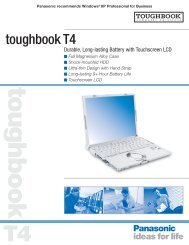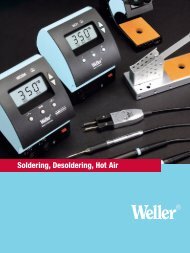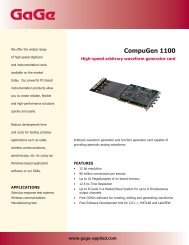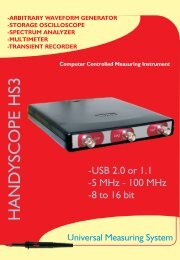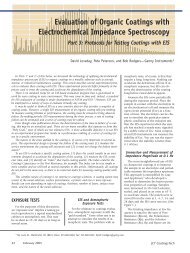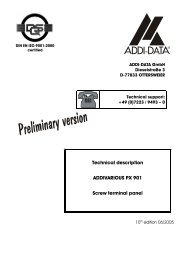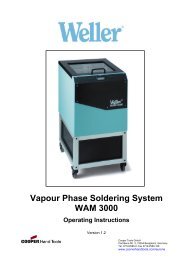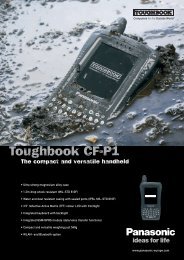CompuScope SDK Manua.. - Egmont Instruments
CompuScope SDK Manua.. - Egmont Instruments
CompuScope SDK Manua.. - Egmont Instruments
Create successful ePaper yourself
Turn your PDF publications into a flip-book with our unique Google optimized e-Paper software.
On-Board MemoryOrganization of the<strong>CompuScope</strong> CardsThe A/D speeds at which <strong>CompuScope</strong> cards produce digital data can be too fast for the IBM PC bus. Themaximum transfer rate for the PCI bus is approximately 120 Mbytes/second while the maximum transferrate for the ISA bus is approximately 1.5 Mbytes/second. Consequently, all the <strong>CompuScope</strong> boards havehigh-speed on-board memory to store the digital data. The PC only accesses this data after the acquisitionis over.A/D Data StorageData from the <strong>CompuScope</strong> A/D converters are stored in on-board Static Memory (SRAM), which isconfigured as a circular buffer. A circular buffer is used to allow capture of data before a trigger event isdetected.The sequence of events that occur during a <strong>CompuScope</strong> data capture is as follows. This is list of low-levelsteps given purely for illustrative purposes. <strong>CompuScope</strong> users implement high-level driver subroutinecalls, which typically execute several low-level steps at once.—The PC’s CPU tells the <strong>CompuScope</strong> to GET DATA using the Get Data bit.—The BUSY flag is set by the <strong>CompuScope</strong> so that the PCI bus is denied any further access to the onboardmemory.—The on-board memory counters are initialized to ZERO by software and start counting up, therebystarting data storage at memory address ZERO.—The system waits for a trigger event to occur while it is storing data in the on-board memory. These dataare called Pre-Trigger data.—When the trigger event occurs, the on-board memory counter value is stored as the trigger address.—Once the trigger event occurs, a specified number of Post Trigger points are captured. The number ofPost Trigger Points were previously specified by writing to the registers on the <strong>CompuScope</strong>.—After capturing and storing the specified number of Post Trigger Points, acquisition is terminated. TheBUSY flag is then reset and the PCI bus is allowed to access the on-board memory.A graphical representation of the above sequence is shown below:Page 14<strong>CompuScope</strong> <strong>SDK</strong> <strong>Manua</strong>l



